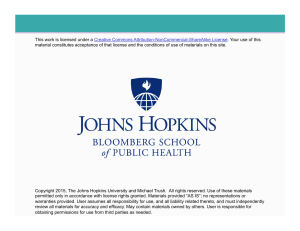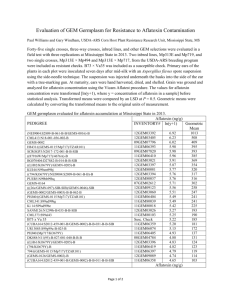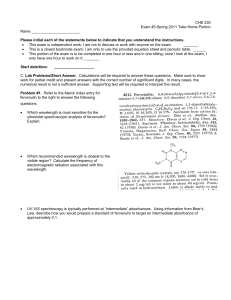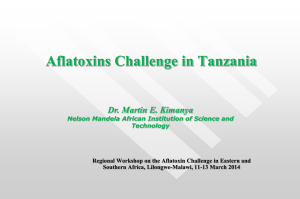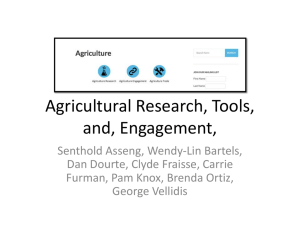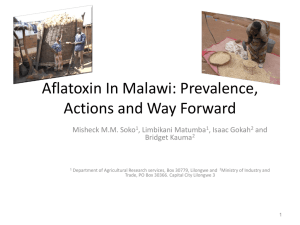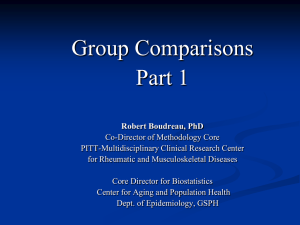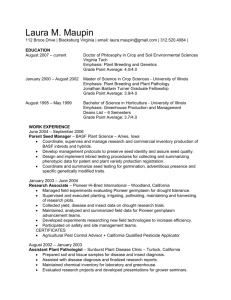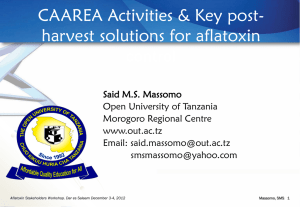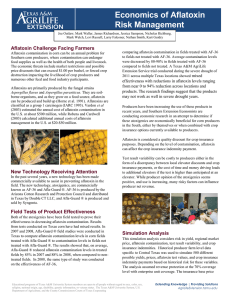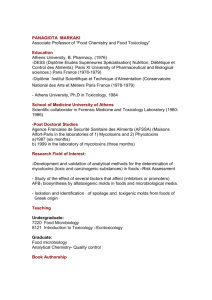Collaboration with Agro-dealers/Commercial Sector
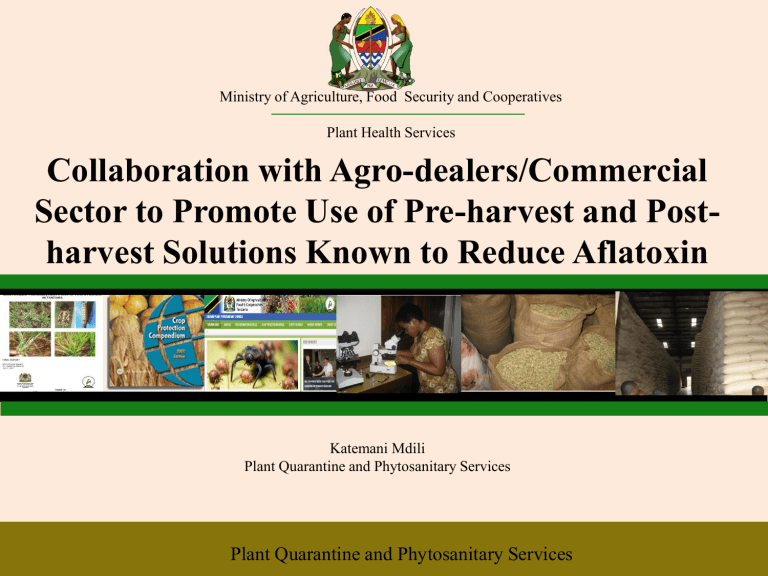
Ministry of Agriculture, Food Security and Cooperatives
Plant Health Services
Collaboration with Agro-dealers/Commercial
Sector to Promote Use of Pre-harvest and Postharvest Solutions Known to Reduce Aflatoxin
Katemani Mdili
Plant Quarantine and Phytosanitary Services
Plant Quarantine and Phytosanitary Services
Key Questions
•
Are the initiatives undertaken by the Ministry enough to address the issue of aflatoxin?
•
Can the agro dealers/ Commercial Sector have an impact towards reducing aflatoxin given opportunity to work in collaboration with the
Government?
Risk of aflatoxin
Risk of aflatoxin contamination of food and feed in East Africa is increasing
Contributing factors: i) environmental factors high humidity and temperature favour fungal propagation, drought conditions increase risk of aflatoxin ii) agronomic factorsLow-input farming practices iii) socio-economic factorsFood insecurity, Limited choice for low risk and high value
Solution to Control of aflatoxin
•
The control of mycotoxins is a complex process
• an integrated quality control program is needed throughout the production chain
• molds producing mycotoxins can either penetrate food before harvest during the postharvest stages
Pre and Post harvest Solution
•
Several methods of pre-harvest handling and best practices for post-harvest handling can reduce contamination
•
To fully address this in a comprehensive approach
Country has to embrace Good Agricultural
Practices
•
The concept of GAP evolved recently as a result of the big concern about food safety and quality , and the environmental sustainability of agriculture
Pre and Post harvest Solution
•
In a broad sense
“GAP applies available knowledge in addressing environmental, economic and social sustainability for on-farm production and post-production processing , resulting in safe and healthy food and non-food agricultural products produce”
•
Through the MoA this approach is being gradually instigated and sensitized to farmers
Strategic Areas
•
Seed, crop selection and seedlings production
•
Create understanding of the importance of selecting suitable seeds and crops suitable for growing condition and that comply with market requirement
• understand the importance of using pure certified seed
• understand key questions on suitability of crop for small-holder
• production.
•
Crop pests and diseases
• understand the impact of crop enemies and the needs for plant protection strategies
• able to carry out observations on pests and disease
• understand crop infestation and damage during production and postharvest
Strategic Areas
•
Integrated pest management (IPM)
• understand IPM approach in managing crop pests
• understand crop protection principles
•
Pesticide application
•
Understanding pesticide best practices
•
Understanding the importance of pesticide safe use
•
Understanding the importance of observing MRL
Post harvest crop management practices
•
Highlighting the most important intervention areas such as food processing, storage strategies such as drying and improving conditions.
•
Control Insect and pest management
•
Aflatoxin contamination has been shown to increase with storage period
Inspection and Detection
•
MoA through Plant Health Services have the mandate to regulate agric commodities destined for imports and exports
– Conducting Pest Risk Analyses
– Exit/Entry points Inspection
–
Warehouse and Go down Inspection
World distribution of Aspergillus flavus
Tanzania Plant Quarantine and Phytosanitary Services
Inspectorate Border Posts
MTUKULA
SIRALI
MUSOMA PORT
NAMANGA
RUSUMO
KABANGA
TARAKEA
MWANZA PORT
HOLILI
MABAMBA
MANYOVU
KIA
HOLOHOLO
ISAKA
TENGERU
KIGOMA PORT
TANGA HABOUR
KALYA
KAREMA
DAR HABOUR
TAZARA
JNIA
KASANGA
KASESHA
KASUMULO
TUNDUMA
ITUNGI PORT
MTWARA PORT
MBAMBA BAY
MTAMBASWALA
Intercepted Materials
Intercepted Materials
Intercepted Materials
Potential Challenges
•
Limited resource personnel to deliver Extension
Services
• incentives, subsidies and policy instruments related to agricultural trade
• product certification, labelling and consumer trends
•
Can the Government do all these by itself?
•
Is there need for a third party certification system?
• consistency with food security measures and priorities of limited resource or potentially marginalized groups
How do we address these challenges?
Can the commercial sector be an integral part in finding the sound solutions that will ensure food safety?
Thank you
